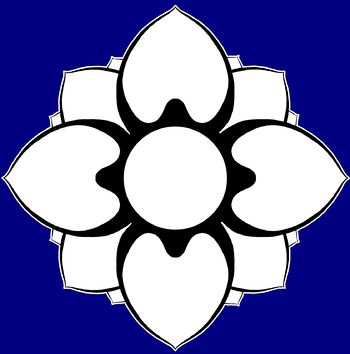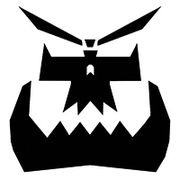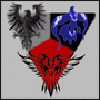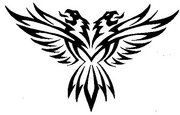Below is a list of the remaining five basics shots. I have tried to focus on the motions required for the sort of "base case" of the attack, the version I would teach a new fighter. By learning these shots, one begins to be able to see how they can adjust a swing to change targets or combine motions to make a different swing.
The Pop Shot
This is one of the lesser used attacks out of the basics. It doesn't hit particularly hard, and has some limits on usefulness. The big advantage is that it is super fast at hitting an exposed shoulder. Despite being seldom used, it is perhaps one of the easiest attacks to learn and uses very simple motions.
The goal of the pop shot is to go from guard to hitting the opponent's shield side shoulder (assuming righty vs righty) as quickly as possible. Now, your arm is already slightly cocked in guard, with the elbow bent a bit. This usually ends up with your forearm roughly pointed at the target's shoulder. The sword tip is slightly tilted in towards you head/shield.
In order to hit the target's shoulder, you'll need your sword to both get closer and to align with the target. Getting closer is as easy as punching forward with the arm directly towards the target, extending the wrist with a snap at the end to get the most range possible as the sword angles forward. Aligning the sword is just a small rotation of the wrist done in conjunction with extending the arm. Just like with our look at how to swing a sword, extra power (and range) comes from rotating the shoulders/torso towards the target, starting with your hips.
Unlike most swings, the pop shot ends up being somewhat more like "pushing" your sword into a target, rather than a typical slashing motion. This motion makes the pop shot a building block for other "swings" that use similar motions of the wrist after moving the arm towards a target.
Recovering a pop shot that hits a target is fairly easy. The sword will naturally bounce up from the target, so raising the hand and pulling back to guard takes a minimal amount of effort. This does leave you forearm exposed briefly until you can fully recover. Overswings with the pop shot, especially with a heavier sword, are much more difficult to manage. Perhaps the easiest recovery is to carry the force down by rolling the wrist, twirling the sword to the outside and back up towards guard.
The Wrap Shot
What I might consider the opposite approach to the pop shot, the wrap is designed to go around a target's defenses and hit with the back of the blade. This means that it doesn't take the shortest or fastest route. Also unlike the pop shot, the wrap generally carries a decent amount of force into the shot and is probably the shot newer fighters struggle with learning the most. Because of the position required to strike, a wrap shot is best used at close/point-blank range. It can be used further away occasionally to hit arms, but it is only really possible to hit a torso shot from that short range.
There are many different variations of the wrap shot, but the one we generally start out teaching newer fighters is a basic, wide wrap aimed towards the middle of the opponent's back or shield arm. This isn't the most direct or efficient wrap shot, but it allows someone to learn the motions a little easier. The swing starts much like our basic swing with tipping the sword to the outside, rotating the torso toward the target, bringing the elbow in towards the body, and extending the arm all in one motion to propel the sword in a bit of a corkscrew. The difference comes from carrying the corkscrew motion around by rolling the wrist over, causing the blade to turn such that the back edge is towards the target. After rotating the wrist, the elbow should naturally want to bend out as the shot hits. At this point, starting your recovery with the torso will pull the shot towards you a bit, giving it slightly more power.
A good wrap shot will feel smooth for most of the motion. Should you start rotating your wrist too late or too early, you'll end up fighting against the motion rather than redirecting the hit. A good way to feel how the motion should be working is to simply swing your sword back and forth loosely by your side, rotating the wrist as it passes by your hip. You are looking for that same smoothness when throwing a wrap shot.
The motion itself requires rolling the hand/wrist over mid swing. Improperly timed, that can lead to a ton of strain on the wrist and elbow. If the swing is interrupted during the transition from front to back of the blade, it causes additional strain on the arm. For these reasons I generally recommend not overdoing it on practicing wrap shots. Try to space out the practice and focus on the motion, before trying to deliver extra power.
The Chop
Unlike the finesse used in a pop shot, or the technique used in a wrap, the chop shot is a shot that focuses on using the torso's power to deliver a solid blow. A very common use is to attack the "slot" between the opponent's sword and shield, particularly as they throw a wide wrap or are recovering from a swing, aiming for the inside of their forearm. One reason this particular chop is used regularly is because the natural motion of blocking (with a shield) will cause your body to rotate into the shot.
The shot is very simple overall. Rotate the torso towards the target. As the torso rotates, slightly extend the arm to draw the sword down into their arm. You'll notice here that wrist motion is minimal. In fact, much of the shot is done with a locked wrist, specifically as the blow lands. Other than extending, the arm doesn't move much either. Overall, chop shots rely on the torso's rotation for a vast majority of their power. In order to hit solid, more rotation is generally used, including as part of the follow through.
Because of the limited arm and wrist motion, the basic chop shot is also slightly shorter ranged than other swings. Its advantages come from power and, as in the above example, efficiency of motion. The chop to the inside of their arm is perhaps the fastest swing to use in that example because it causes the sword to take the most direct route to the target with very little wasted motion.
The Short Cross
This is a very common attack for righty vs righty because it targets the enemy's sword side. A successful cross shot can tie up the enemy sword or put an opponent onto the defensive to avoid leaving their sword arm open. Here I am breaking the cross shot into two types, the short cross and the high cross. While very similar in basic execution, they differ in range, utility, and risk.
Much like the pop shot, the short cross uses a punching motion. However, the short cross adds wrist and further torso rotation towards the target's sword side. The shot ends with a wrist extension.
That sure sounds a lot like a pop shot pointed at a different target, doesn't it? Yes, kind of, which illustrates why learning the basic shots is important for developing further. The difference here though, is the the short cross has far more power than if you were to execute it more like a pop shot by simply aiming your arm, then punching out. That extra power comes from the rotation of the arm.
One important note about cross shots is that due to the rotation, they have a tendency not hit squarely on the blade, often closer to corner of the blade or even flat depending on where they meet the target. Many vets will actually angle their sword in the hand to compensate before/as they throw a cross to ensure a cleaner hit and avoid flatting someone. While other shots have similar rotation, they generally follow a wider, more complete arc, giving the swing more time to level out the rotation.
For lefties, the short cross can be an important tool to have as it is one of the few techniques that effectively targets a righty's shield side. Many righties shift their shield over towards their sword side to help guard against a lefty. This leaves their shield side somewhat vulnerable.
The High Cross
While I am including it in this fundamentals post, the shot by itself isn't ideal. Later on, adding shield work, footwork, and combos into the mix helps make up for many of the shortcomings of the high cross. The swing itself is much like what a short cross would become with a bad overswing or over rotation. Rather than targeting a sword, the attack targets the opponent's chest/gut/hip. The main problem with the shot is that in order to be able to land it on a target, you have to be in a position that the opponent can hit a similar target on you with the same technique. This is one of the largest causes of simultaneous deaths.
The way the swing is often executed, in addition to the normal motion of a short cross, the rotation is aided by raising the elbow and bending the torso with the swing. This change in position also helps aid the sword in angling straight down, ideally somewhat parallel to their shield so it might pass behind it. This angle is what makes it a shorter ranged attack than the short cross as your sword can't be fully extended out and also pass behind their shield.
Now, because the high cross is rotating so far, an overswing can be painful, and there isn't a great way to recover the force due to the awkward position. Because of being so hard to recover, the overswing will leave your arm and defenses vulnerable. For these reason, it is generally safer to avoid throwing a high cross at its max range, as an opponent may well move back and cause an overswing.
The Sweep
Attacking the opponent's legs, a sweep follows the curve of their shield down into the leg. While I can utilize some variant of the basic swing, wrap, or even the pop to attack the leg, a sweep can be more ideally suited for the job. As I have discussed on the range game before, leg attacks require one to be closer to the target and some extra work to help close the distance.
The motions of the arm are much the same as the basic swing, but the forearm takes a wider arc to the outside as the arm lowers a bit. This makes the sword follow a smoother, wider circle than the basic swing. Following this arm motion, without adjusting the body, will result in either being out of range or likely hitting the bottom of the shield
In order to compensate for this problem, many newer fighters are temped to lean their torso forward. This causes one's shoulder, or even back, to be highly exposed to the opponent. Most of the range and positioning can more safely be done by bending the knees. This brings the shoulder lower and closer to the target, which improves range. It also keeps your body centered and guard relatively intact, especially with a shield.
One could also choose to lean slightly towards the sword side, causing a dip in that shoulder, while simultaneously shifting weight onto the the sword side leg (if it is forward). This still keeps ones guard relatively intact, but does have a couple of problems. For starters, this lean ends up placing your head in the path of a common counter swing used against sweeps, which will result in getting hit in the head many more times than simply bending both knees. The other problem is that your weight ends up almost entirely on one leg, making it an easier target and reducing your ability to dodge other attacks.
Recovering from an overswung sweep, or even some hits, it is often easiest to sort of complete the circle, rather than pulling the sword back. During the swing and the recovery, the arm is much more exposed to attack than during many other swings because the hand has to be so much lower than the normal guard.







